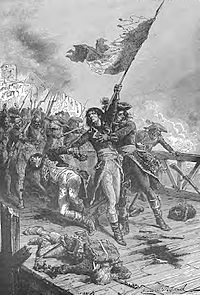|
Napoleon III Rewards an Old Veteran
Campaigning against Austria in Italy in 1859, French Emperor Napoleon III learned that a veteran of his uncle’s Italian Campaign of 1796 was living in Alessandria, in Piedmont. So one morning he summoned the man to his headquarters.
The old veteran, by name Didier Fleuret, attended mass with the new Napoleon. Afterwards he gave an animated account of his role in the three-day battle of Arcola (Nov. 15-17, 1796), telling of his part in the famous attack on the first day, describing how, flag in hand, young General Buonaparte had led his men storming across a narrow bridge through a hail of fire, to emerge unscathed, despite men falling dead and wounded by his side, among them the old soldier himself, hit three times. When the old man had finished his tale, Napoleon III called him to attention in front of his massed troops, a matter which the old fellow did with a panache that betrayed him as the veteran he was. Then the Emperor pinned to Fleuret's breast the Croix de chevalier of the Legion of Honor. Overcome with emotion, the old soldier attempted to express his thanks, but managed to utter only one or two incoherent words before bursting into tears. Within seconds there were loud cries of "Vive L'empereur!" from the troops and not a dry eye to be seen.
The incident greatly boosted Napoleon III’s prestige among the troops, which perhaps helped them secure victory in the war over the next few weeks, which was fortunate, since "Napoleon the Little" only came close to measuring up to his uncle’s standards of generalship, mostly in such theatrical gestures.
FootNote 1: What Really Happened at the Bridge of Arcola? Bonaparte did not charge across the bridge at the head of his troops. But he did stand holding the colors "about 55 paces" from the bridge as his troops stormed across. He was under fire, and one of his aides was killed at his side, so he was brave enough, albeit not quite as heroic as the “Napoleonic Myth” would have us believe.
FootNote 2: The name “Didier Fleuret” is current borne by a surprising number of people in France, most notably by the president of the French football club La Berrichonne de Châteauroux.

Bonaparte Leading the Troops Across the Bridge at Arcola,
the traditional image
--Courtesy Wikipedia
West African Personnel in British Military Service, July 1945
All colonial powers raised military forces from their “native” subjects. These were usually small, lightly equipped forces used primarily for internal security in the various colonies, and they were frequently administered by the colonial ministry rather than the war ministry. During the world wars, however, the various colonial powers quickly recognized the value of “native” manpower, and the numbers in service expanded enormously, armed, equipped, and trained for conventional operations and at times even transferred to the control of the war ministry. While many colonial troops were used largely as garrison forces to free troops from the “Mother Country” to fight, others found themselves committed to conventional operations against great power forces or other colonial troops.
During World War II, Britain’s West African colonies furnished nearly 165,000 troops for imperial service, many of whom saw action in Italian Somaliland, Ethiopia, Eritrea, and especially Burma.
| |
Army
|
RAF
|
RN
|
Total
|
|
Gambia
|
3,750
|
600
|
100
|
4,450
|
|
Gold Coast
|
45,000
|
1,700
|
300
|
47,000
|
|
Nigeria
|
90,000
|
1,700
|
300
|
92,000
|
|
Sierra Leone
|
1,000
|
900
|
3,500
|
21,400
|
|
Totals
|
155,750
|
4,900
|
4,200
|
164,850
|
Some notion of the extent of the mobilization can be gained by noting that the pre-war colonial force in the Gold Coast, the Gold Coast Regiment (an element of the Royal West African Frontier Force or RWAFF), was a light infantry unit of about 1,000 men under British officers. The troops were largely recruited from the Northern Territories of the colony, and even included some men who had slipped over from adjacent parts of French West Africa, the colonial frontiers being largely indifferent to local ethnic boundaries. During the war, the Gold Coast contribution to the RWAFF increased more than 45-fold, without counting some men who served in the RAF or the Royal Navy, which pre-war had no West African personnel.
The service of the Gold Coast Regiment was fairly typical of the contingents from West Africa. In 1940 and 1941 many of the troops campaigned in Italian East Africa, while some spent the period from mid-1940 to late 1942 observing the frontiers of various Vichyite colonies in Africa and the Middle East. From 1943 onwards men of the Gold Coast Regiment also served in India and Burma, as part of two divisions composed largely of men from Britain’s West African colonies, who fought alongside a division of men from Britain’s East African colonies.
In the post-war era, veterans formed an important bloc in the independence movements of many of the West African colonies. And after decolonialization, the component elements of the RWAFF became the cadres of the new national armies, though professionalism often suffered.
More...
|